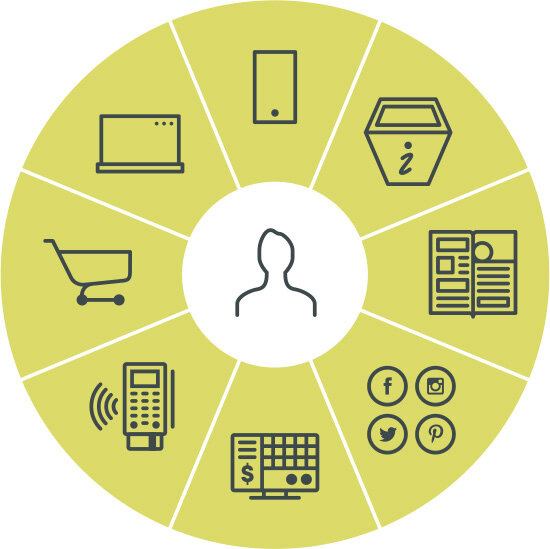There’s a profound shift unfolding right now in the way retail technologies are assessed, implemented and integrated. And the primary force behind this upheaval is changing consumer expectations for a “phygital” shopping experience.
Many retailers have had to take a ‘just get something done’ approach to creating seamless customer experiences that span digital and physical channels. Now they’re struggling with omnichannel set-ups that only link systems together and can’t keep pace with changing consumer behaviours.
Many also face a technology cliff, with legacy solutions so old that they’re no longer fit for purpose or unable to support their phygital ambitions.
In addition, around 2 in 5 retailers (40%) lack in-house expertise to make the most of new technologies, and only 25% of retailers can connect online and store data to create the omnichannel experiences consumers now expect.
But omnichannel should not be the end goal. It’s just one approach to getting a single view of your customers that will help you deliver unified experiences.
Instead, a unified commerce approach will break down your channel silos and move your retail business toward the holy grail of holistic, real-time, personalised customer experiences spanning in-store, online and everywhere in between.
To help explain why unified commerce is the nirvana of omnichannel, here’s a look at where we are now and where we’re going.
Multi-channel
To keep pace with new technologies and changing consumer demands, retailers are giving customers access to new mobile and online channels. In a multi-channel approach, each touchpoint and channel operates independently, with separate people, processes and technologies existing in functional silos.
But when you only add and don’t actually integrate new channels with the rest of your organisation, you create bad service experiences that frustrate internal teams and customers.
Silos mean that your customers have to deal with inconsistencies and gaps, such as incomplete sales histories, different tones of voice or having to start conversations afresh in each channel. These silos inevitably lead to disappointment and frustration, a lack of trust and even a sense that your organisation is incompetent.
Omnichannel
With an omnichannel approach, you’re connecting numerous backend systems so that customers can seamlessly interact with your brand. However, your channels are still operating in functional silos.
That means most attempts to offer unified experiences fall short.
You’re likely to be struggling with legacy technologies that have been customised and are infrequently updated, and then you bolt on new solutions that don’t easily integrate. These omnichannel systems are fragile, inefficient and costly to maintain.
And things can easily unravel. Adding new channels and tools requires additional custom integrations that are complex and slow, adding significant costs and curbing the agility and scalability you require.
Unified commerce
Unified commerce provides a central hub that breaks down the silos between channels and backend systems to deliver truly seamless experiences, while also solving omnichannel’s biggest weakness – operational complexity. Rather than building custom integrations to unify different systems, you can easily use all the tools and services within a single unified platform.
With a unified commerce approach, you can achieve retail nirvana by creating immersive and frictionless experiences for customers across all channels, touchpoints and locations. It gives you a single source of truth for inventory, order and customer data. With this one view of the customer, and all channels and engagement points connected in real-time, you can deliver a personalised and consistent customer experience.
You can also quickly respond to changing customer expectations and new technologies by using microservices and APIs to expose data and connect third-party services.
Unified commerce has been a game changer for our clients.
It eliminates the customer journey pain points and amplifies the ‘wow’ moments. Now you can treat each customer as an individual, all the time – one person with one account, interacting with one brand.
Unified commerce can benefit your business in many ways:
Simplify your technology
A single commerce platform gives you a leaner and more flexible architecture to deliver greater agility, increased efficiency, more control and cost savings.
Accelerate speed to market
These improvements in IT efficiency and flexibility let you launch new tools and services to meet business demands and start seeing revenue benefits faster.
Optimise inventory and availability
Your most significant benefit will be increased sales generated by ranging and fulfilment capabilities that enable you to sell products across channels (and even sell products not normally stocked within any channels).
Boost in-store productivity and sales
By arming your store staff with the right customer data and tools, combined with AI-driven recommendations, they can more easily make decisions, provide personalised upselling advice, sell inventory at any location and serve customers faster, anywhere in the store.
Personalise your customer experience
With a holistic view of your customers, you can better plan your pricing and promotion strategies and get the right offer or message to the right customer, at the right time and right place.
Create relevant and agile experiences
With a single source of truth and powerful analytics, you can turn large amounts of data from disparate sources into insights that help you to attract and engage customers in new ways and improve your bottom line.
The result is the ability to deliver the personal, ubiquitous and unified experiences your customers expect, fostering loyalty, driving growth and improving profitability.
This post was originally published on 3 March 2020 and updated on 08 August 2024.
Want help to plan your next steps?
We can help you define your goals, develop a business case and create your roadmap to deliver the unified experiences that are best for customers, and most profitable for you. Get in touch.











